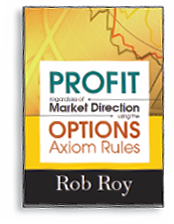.jpg)
Follow
Us:    
|
Imagine getting paid
instant cash... and lots of it...
any time you want!
Better still, imagine having more money from the same trade dumped into your account just a few days later...
This you’ve got to see!
Bubba’s Instant Cash Flow
The double-dipping secret revealed in this video was discovered by Todd “Bubba” Horwitz, who spent decades as a floor-trader & market-maker.
It’s powerful, foolproof, and surprisingly easy to do!
You can also get a free copy of Bubba’s eye-opening new eBook: How to Get Rich Off Trump Market Mania With ZERO Risk.
Get FREE eBook & Watch Video

|
|
Inspired by conversations with multi-millionaires on the golf course, Rob left his 13-year career as a PGA Golf Professional to enter the world of finance. In the process of getting his securities licenses Rob discovered options. And, using an innovative approach to proven strategies, he achieved astonishing results trading his own account.
As time went on, Rob felt compelled to help the down-trodden little guy. One thing lead to another and before long Rob found himself traveling around the world as an independent contractor giving seminars on his unique approach to winning 9-out-of-10 trades and earning triple-digit returns nearing 200% year after year.
In January 2012 Rob launched his Option Axiom website. Now you too can reap the benefit of Rob Roy’s unique approach to earning superstar profits.
 |
Special Limited Time
Preferred Membership Offer
FREE Option Axiom Rules Course
Includes DVD & Manual

Please, don’t let the somewhat dry-sounding title fool you. If you find making money exciting, you’ll be on the edge of your seat throughout the entire video. And within hours you’ll be placing trades... and hitting the Profit $weet-$pot... just like a seasoned pro!
Not only that, you can pass on a legacy of financial freedom to family and friends by simply lending them your eye-opening Option Axiom Rules DVD!
And you’ll also enjoy having the comprehensive Option Axiom Rules manual sitting next to your computer for easy reference at any time.
Learn more about
this exciting offer!
Option Axiom Rules Trading Course
|
|

Better
Business Bureau
 |
|
Click on authors name
to learn more
|
| |
|
|
Inside Trading this week features Rob Roy. Rob explains how options react to a change in the stock price.
Lee Gettess brings us our next bit of insight with a video covering his market expectations for the next week.
Our third article is authored by Duane Davis who tells us how traders can benefit from the use of Fibonacci ratios.
Last, Chris Verhaegh presents his PULSE Options Weekly Newsletter.
Enjoy!
Adrienne LaVigne
TradeWins Publishing
 |
|
Stock Price Movement
by
Rob Roy
The following
is an excerpt from Rob Roy's Option Axiom Rules Trading Course
The more time there is to expiration, the less sensitive the option is to stock price movement. The less time-to-expiration, the more sensitive the option is to stock price movement. The reason for this goes back to the Greek Gamma. The closer to expiration the option is, the more gamma – rate in change of delta, or sensitivity to price change – the option will have. The farther out in time, the less gamma the option will have. To understand the difference in sensitivity to stock price change, take a look at the graphs below.
The top graph is the March 2012 expiration 50 strike call that was bought for $1.45 ($145 per contract price). The bottom graph is the January 2013 expiration 50 strike call that was bought for $5.80 ($580 per contract). There are 28 days to expiration for the March contract and 334 days to expiration for the January contract.
The stock price moved from $50 per share to $55 per share. From that $5 move in the stock price the MAR 50 call made $370 of profit, while the JAN 50 call made only $300 of profit. The only difference between the two trades is the time to expiration, and the cost of each trade. The March 2012 options with only 28 days to expiration made a full $70 more than the January 2013. The truth of the two positions comes out when a trader takes a look at the return on the capital. The March 2012 50 strike call made 225% return, while the January 2013 50 strike call only made a 52% return. This difference in return on capital comes from the simple fact that the March expiration option has less time to expiration, therefore less cost as well. The closer to expiration options will react faster to a change in the stock price.
What is true for profiting in a trade is also true for losing on a trade. The nearer to expiration options do make money faster with a stock price in change. That also means they lose money faster if the stock was to move against them.
Stock Price Movement
|
Lee
Gettess' Market Sense
by Lee Gettess
Lee
Gettess is a top trader who is excited
to bring you his video newsletter.
Each week, Lee will share his predictions
on what he anticipates from the bond
and S&P markets.
Watch
Video
|
Fibonacci Ratios
by Duane Davis
The following
is an excerpt from Duane Davis' DIY Success Package
The Fibonacci number sequence is a mathematical cycle that incorporates the expansion and contraction of all elements in nature, from the growth of the smallest leaf on Earth to the largest galaxy in the universe.
The Fibonacci number sequence was named after Leonardo of Pisa, also known as Fibonacci. Although this number sequence had been described earlier in the 6th century AD by the mathematician Virahanka, it’s best known today as The Fibonacci Sequence.
This cycle beings with the number 0. The next number is the number 1. Each following number is the sum of the two preceding numbers. To arrive at the third number in the sequence, the preceding two numbers are added together and the result is 0 + 1 = 1.
The fourth number in the sequence becomes 1 + 1 = 2.
The fifth number is 1 + 2 = 3.
The sixth number is 2 + 3 = 5.
The seventh number is 3 + 5 = 8.
The eighth number is 5 + 8 = 13.
There is no end to the sequence, it goes to infinity.
Fibonacci Ratios
|
PULSE Options Weekly Newsletter
by Chris Verhaegh
The following is an excerpt from Chris Verhaegh's PULSE Options Weekly Newsletter
Every week Chris publishes his “PULSE Options Weekly Newsletter”. The following is an excerpt from his most recent issue.
First Things First
I will start chronologically with the French Election. Last month voters in France went to the polls for the first round of their Presidential Election. Since no candidate received over 50% of the vote, the top two vote getters face each other in Sunday’s winner take all election.
While a shocking outcome may cause excess volatility, it is possible that the market reacts in sort of a “Buy Rumor, Sell the Fact” reversal of expectations. We should have the results of this election Monday morning before the markets open in the US.
Speaking of the US, let’s look at a chronological list of stocks releasing their Earnings next week. Understand this is not a complete list; it’s more of a list of the stocks with Earnings Announcements which warrant our attention.
Monday, May 8
After the Close: Tesoro Petroleum (TSO)
Tuesday, May 9
Before the Open: Duke Energy (DUK)
After the Close: Nvidia Corp (NVDA), Walt Disney (DIS), Priceline (PC)
Wednesday, May 10
After the Close: Whole Foods (WFM)
Thursday, May 11
Before the Open: Macy’s (M), Kohl’s Corp (KSS)
To Learn More Click Here
|
|